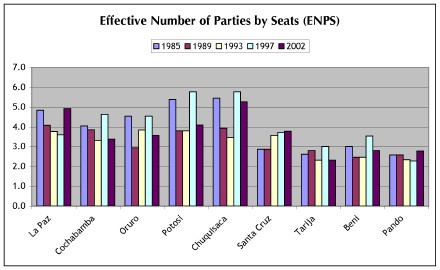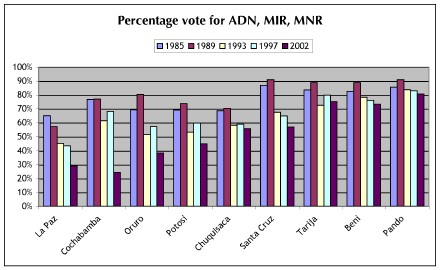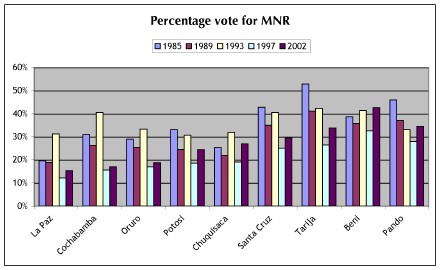A snapshot of two Bolivias
04.22.2004Lately, there's talk of "two Bolivias" — between the eastern departments of the "media luna" (Santa Cruz, Tarija, Beni, Pando) and the Andean departments (La Paz, Cochabamba, Oruro, Potosí), w/ Chuquisaca playing an intermediate role (recently leaning towards the "media luna" side). This difference always existed, but it's been exacerbated after October's "guerra del gas" — in which the Andean altiplano rose up to protest the export of natural gas (which rests in "media luna" departments).
But. Do these regional differences reflect in electoral data? That's a question I ask in a paper (hopefully finished before the end of the weekend). I've already crunched the numbers, after a few trips to the Corte Nacional Electoral (CNE). And. Yes. There are two Bolivias. Here's a little bit of the data I looked at:
The graph below shows by-department measures for "effective number of parties" (ENP). The measure — developed by Laakso & Taagepera (1979)* — estimates the number of "effective" parties (those worth counting) in a political system. A characteristics of a "consolidated" party system is that it has a stable number of parties, and that these are few in number (a "good" ENP value for a multiparty system is between 3-4). You can calculate ENPV (using votes) or ENPS (using lower house seats). The difference between the two, in the Bolivian case, is slight (since it uses PR electoral formulas w/ low Gallagher index of disproportionality measures).

Notice the dramatic difference in structure between Andean & "media luna" departments. Here, there's 2-3 effective parties (a slight increase in Santa Cruz' figures could be accounted by massive immigration from the west).
The next graph shows by-department vote percentages for the "systemic" parties (ADN, MIR, MNR). These three parties were the largest in the transition-to-democracy period. Much of the current criticism of the party system, including the post-October meme that the parties are no longer legitimate, depends on regional context.

Notice the dramatic drop in votes for these three in the Andean departments, while the vote structure remains steady (and high) in the east. Also, these parties' vote share in 2002 was still over 50% in all of these (including Chuquisaca) — over 70% for Tarija, Beni, and Pando. Again, the Santa Cruz drop could be attributed to recent immigration trends as westerners move to the city — into slum neighborhoods that tend to vote for UCS (a populist party). Still, lowest figures for Santa Cruz are close to the highest for La Paz.
Finally, this graph shows by-department vote percentages for the MNR — the party of deposed president, Gonzalo Sánchez de Lozada.

Notice that MNR votes were always higher in the east, but remained high. MNR votes were lowest in the Andean west, and fell over time — especially in populous La Paz & Cochabamba. Look at the figures w/ the other graphs in context. In the "media luna" departments, the MNR regularly wins more than 30% of the vote (even in elections it lost).
What that means is that the party system meets many of the conditions for "consolidation" in the Santa Cruz, Tarija, Beni, and Pando. The Andean half of the country, on the other hand, has a highly unstable party system, which actually changes dramatically between elections. In the 1990s, CONDEPA dominated La Paz (but had no impact in the east), before fading into insignificance. In 2002, MAS & NFR (two new populist parties) preside over a virtual two-party system in Cochabamba, w/ no impact in the east. There's no longer a "national" party system; parties center on regional constituencies — and that might be bad news.
-----
*: See Laakso and Taagepera, “‘Effective’ Number of Parties: A Measure with Application to West Europe,” Comparative Political Studies 12, no 1 (1979): 3-27. I posted the basic formula (w/ explanation) here.
See related post here.
Posted by Miguel at 12:05 PM
Comments
This is great info! I am not sure how all this split country stuff fits into your grad work, but I am sure it is exciting and interesting to be in the country and seeing all this first hand. Also to be able to get more access to information the mayeb most because of your Fullbright status. A few more months and you will be in the States... enjoy the time!
Posted by: sam at April 22, 2004 12:40 PM
My friend, I have been monitoring your blog for a while and your post of the "two Bolivias" just struck a nerve. The "buzz" you are hearing about this concept comes from no other than the separatists of "Nacion Camba" (N.C). The bolivian variety of the new tribalism and sub-nationalism that runs rampant through so many regions of the world (East Timor,The Balkans, West Africa) bringing about not progress or integration but destruction and atrocity.
I have studied the bolivian phenomenom for the last four months and I'm working in a rebuttal of Mr. Antelo's thesis.
The graphs and statistics you are presenting are nothing but snapshots of a greater country: BOLIVIA the progress of one or other region is the fruit of joined efforts and common work. Decades of work from EVERYBODY in this nation we call Bolivia.
Please explore this topic with more academic responsibility.
Jonathan
PS: Te escribo en Inglés porque al parecer ese es el idioma de la mayoría de tus lectores.
Posted by: Jonathan Olguin at April 24, 2004 08:50 PM
I agree w/ your assesment in general. My study is meant to show that the new MMP electoral system has hightened these regional animosities, and should be replaced by a system that lessens them. Also, the "two Bolivias" discourse was first presented by Felipe Quispe, who spoke of Aymara secessionism.
Posted by: Miguel at April 25, 2004 09:54 AM